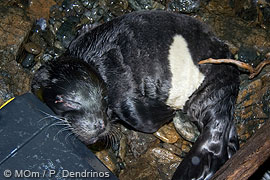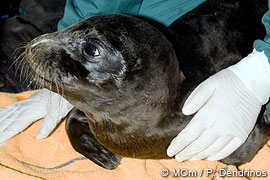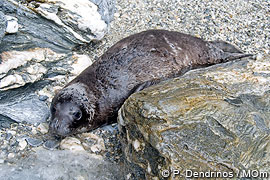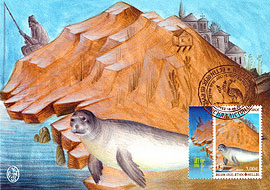


 |
||
 |
||
 |
||
Vol. 13 (2): December 2010 |
||
Greece / Italy / Lebanon / Madeira / Mauritania & Western Sahara / Turkey
Greece
|
 |
 |
|
|
Rescue on Evia. |
In rehab on Alonnisos. |
After receiving first aid, Lazarus was transferred to MOm’s rehabilitation unit on Alonnisos – a small prefabricated building, long overdue for replacement. Veterinary care was overseen by Professor Natasa Komninou of the Veterinary School of the University of Thessaloniki.
As has been the case with other exceptionally young monk seals brought into rehabilitation at the MOm unit, Lazarus continued to lose weight despite regular, round-the-clock feedings.
Body temperature and glucose levels also remained unstable, according to staff.
“Experience has shown that the odds of survival are very small in cases where very young pups have been separated from their mothers for several days,” Emily Joseph, head of MOm’s rehabilitation unit told TMG. “Congruent with blood test results and veterinary examination, Lazaros had already begun the process of starving without his mother’s milk; while his nutritional regime sought to maximize caloric intake, there are limits to how much food a pup’s delicate system can properly digest and, unfortunately in this case, the pup was not able to overcome its debility.”
The pup, reported MOm, died following a seizure on 25 October. A necropsy performed in Athens confirmed the cause of death as starvation.
MOm. 2010. Press release. An orphaned Mediterranean monk seal pup found and rescued in Evoia, 11 October 2010. [PDF  70KB]
70KB]
 |
|
|
Newborn pup on an open beach at Gyaros island, October 2010. |
Already well within the monk seal pupping season in Greece, up until the end of October, 19 newborn pups were recorded by MOm’s Rescue and Information Network, and researchers undertaking a field expedition to the island of Gyaros.
Considering that pupping in Greece occurs up until mid-December and that, due to lack of funds, no monitoring schemes are currently in place in important pupping areas for the species (such as the National Marine Park of Alonnisos Northern Sporades and the Karpathos – Saria island complex), the current figure is reasonably encouraging. In addition, another interesting fact is that for a third consecutive year, pupping has been recorded in the Gulf of Argosaronikos, a densely populated area not far from Athens.
It has to be mentioned, however, that of the nineteen newborn pups recorded, two were found abandoned and malnourished; despite the intensive efforts of MOm’s rescue and rehabilitation staff and colleagues, it was not possible to reverse their health status and they finally succumbed. – Marianna Psaradellis, MOm.
According to MOm's latest reports, 27 births had been recorded by the end of November.
 |
|
|
|
In September 2010 the Hellenic Postal Service issued a new and highly aesthetic collection of stamps – its theme, the biodiversity of the Holy Mountain peninsula (Mt. Athos).
The collection presents the rare species of flora and fauna that have survived in this unique area of northern Greece due to its special historical, religious and natural history. The stamps are based on drawings of monk Father Loukas of the Xenofontos Monastery. One of the stamps depicts the Mediterranean monk seal in a picturesque setting.
In 2009 MOm’s research team received special permission from the Administration of the Holy Mountain to carry out a preliminary investigation of the suitability of the area as monk seal habitat. The entire coastline of the peninsula was circumnavigated by MOm’s research vessel “IFAW-Odysseia” and at least three caves suitable for reproduction and at least another five only for resting were identified. Evidence of recent use was found in two caves and one male seal was observed. It is the first time that reproductive caves of such good quality have been found so far north in the country and further research is required in order to verify their actual use as pupping caves. – Panos Dendrinos, MOm.
For more information on monk seal in the world of stamps, turn to our article Monk Seal Philately, TMG 3(2): 2000.
The European Commission has elected to financially support the LIFE+ Information Communication “Thalassa” project, which was submitted by MOm/Hellenic Society for the Study and Protection of the Monk Seal, in collaboration with WWF-Greece in September 2009. The project is entitled "Thalassa Campaign: Learn, Act, Protect / Awareness, Educational and Participation Campaign for Marine Mammals in Greece”. The project started on September 1st 2010 and is planned to run for 40 months. “Thalassa” constitutes the first integrated communication, sensitisation, environmental education, capacity building and advocacy campaign aiming at the preservation and protection on a national scale of all marine mammals living in Greek seas – monk seals, dolphins and whales – most, if not all of which, are endangered or threatened with extinction. The campaign is supported by the relevant competent national authorities and especially by the Hellenic Ministry for the Environment, Energy and Climate Change. “Thalassa” will inform the general public, relevant stake-holders and specific target groups on the persistent negative pressures to all rare, endangered and important marine mammals inhabiting Greek waters and their habitats, due to human related threats. Furthermore, the actions of the campaign will aim at convincing the Greek society to change its current behaviour, so as to directly promote conservation efforts for the preservation of marine mammals, as key and charismatic elements of the Greek marine natural environment. – Vangelis Paravas, MOm.
Information on the rationale, stated targets and budget of Thalassa is available in a publication issued by the EC: Life+. 2009. Information and Communication. Projects 2009, European Commission, Environment: 1-14. [PDF  934 KB]
934 KB]
The Mediterranean monk seal (Monachus monachus) is the most endangered seal in the world and in urgent need of immediate and effective conservation and management measures. One of the key factors hampering recovery of this threatened species is the substantial lack of information on the animals’ biology and population status. Due to the recent advances in molecular techniques, the genetic study of endangered species is increasingly being used in shaping conservation strategies. In the case of the Mediterranean monk seal, genetic research has been used successfully in understanding the genetic status, population structure and demographic trajectory of the monk seal colony at the Cabo Blanco Peninsula. In contrast, however, little is known with respect to the genetic status of the largest remaining population of the species, in the eastern Mediterranean Basin. Assessing genetic variability and understanding population structure of Mediterranean monk seals in Greece were identified as priority actions for the conservation of the species in the recently revised ‘National Strategy and Action Plan for the Conservation of the Mediterranean Monk seal in Greece 2009 – 2015.’ This plan was developed by MOm/Hellenic Society for the Study and Protection of the Monk seal and has been submitted to the National and European authorities for adoption.
With funding from the U.S. Marine Mammal Commission, researchers from MOm, the Hawaiian Monk Seal Research Program of NOAA and the Hawaii Institute of Marine Biology of the University of Hawaii recently launched a new research initiative to shed light into the “genetic secrets” of the species in the eastern Mediterranean. The general aim of the study is to advance the conservation status of the critically endangered Mediterranean monk seal (Monachus monachus) in Greece through the study of its genome. The specific objectives are to develop a research protocol for the genetic study of the species and to conduct a preliminary assessment of the genetic status of the largest population in the eastern Mediterranean Sea, in Greece.
Currently, approximately 100 samples of necropsied Mediterranean monk seals from Greece have been sent to Hawaii and are being analysed at the same molecular laboratory that previously analysed the genetic diversity and status of the Hawaiian monk seal. The project is expected to be completed by the end of 2012. – Alexandros A. Karamanlidis, MOm and Jennifer Schultz, Hawaii Institute of Marine Biology.
EndQuoteMarine Park scepticism “If you wish to protect endangered species and establish a Maritime Park to do so you have to be serious about regulating the use of the area and policing it. The only such Park in Greece, the Northern Sporades National Maritime Park, established to protect the endangered Mediterranean Monk Seal and other species, is not so regulated or policed. After a good sail from Ay Efstratios we dropped anchor in the deceptively idyllic landlocked bay of Planitis on the island of Kira Panayia or Pelagos. It is no wonder that the last monk seal seen in the area was 15 years ago considering the far from clean water we found in Planitis and the behaviour of large motor cruisers who open their garage doors and disgorge jet skis to buzz around like a swarm of flies for hours on end disturbing not only the wildlife but everything else in the surrounding area including us. It is a shame that someone has not invented a bloody great fly swat that can eliminate these vermin with one swipe. […] The Seal Rescue Centre at Steni Vala on the eastern coast of Alonnisos, a delightful little port and village, with which we fell in love, is a derelict hut that probably died at the same time as the last monk seal.”
|
Mediterranean News continues with Italy, Lebanon, Madeira, Mauritania & Western Sahara and Turkey...
The views expressed by outside contributors do not necessarily reflect those of The Monachus Guardian.
|